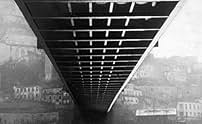Ajouter une intrigue dans votre langueA documentary that looks at the people working in the river Douro, around the city of Porto.A documentary that looks at the people working in the river Douro, around the city of Porto.A documentary that looks at the people working in the river Douro, around the city of Porto.
- Réalisation
- Scénario
Avis à la une
Manoel de Oliveira's first film is a briskly cut summary of a day in the working lives of riverside folk on the banks of the Douro River.
It's an early signpost to later technique, notably his capturing and framing of aesthetically pleasing shots. This is one of the appeals of 'Douro' - it's ravishing to look at - but it's also a valuable document of working practices, and it shows (a little self-consciously, it must be said) the arrival of the technology that would change the face of the river banks around the Ponte de D. Luís, in Porto.
One false and unnecessary note is the introduction of a little fictional vignette of a story - a worker is 'trampled' by oxen, to the great dismay of his sweetheart. But this doesn't take much away from a never-less-than-interesting little film.
It's an early signpost to later technique, notably his capturing and framing of aesthetically pleasing shots. This is one of the appeals of 'Douro' - it's ravishing to look at - but it's also a valuable document of working practices, and it shows (a little self-consciously, it must be said) the arrival of the technology that would change the face of the river banks around the Ponte de D. Luís, in Porto.
One false and unnecessary note is the introduction of a little fictional vignette of a story - a worker is 'trampled' by oxen, to the great dismay of his sweetheart. But this doesn't take much away from a never-less-than-interesting little film.
I believe this is something of an experimental short film/documentary by the director Manoel de Oliveira, but for a first effort the result is satisfying. It basically isn't much more than a portrait of labor and industry around Douro River in the city of Porto, but it stands alone for its innovative filming techniques which attempt to capture as many images and areas of the city as possible - something that could be described as cinematographic liberty.
On paper, the idea of this 'Douro, Faina Fluvial' is simple and even minimalist. Still, it offers things which many so-called more "complete" movies don't, starting with the cinematographic liberty I mentioned.
On paper, the idea of this 'Douro, Faina Fluvial' is simple and even minimalist. Still, it offers things which many so-called more "complete" movies don't, starting with the cinematographic liberty I mentioned.
Oliveira's first film, shot around the harbour in Oporto, Portugal, is an avant-garde series of images of the fishermen and assorted workers of the town. Although there are obvious influences from other 'art' films of the time, it isn't simply a montage of unrelated images, but a vision of a working town, even with so much as a narrative thread running through. The version I have seen (at the London Film Festival 2001) was overseen by the director himself with a new score by Emmanuel Nunes. It is a pounding, vibrant 18 minutes, despite it's limitations.
Le saviez-vous
- AnecdotesShown before Antonio Lopes Ribeiro's "Gado Bravo' (1934).
- ConnexionsEdited into Porto de mon enfance (2001)
Meilleurs choix
Connectez-vous pour évaluer et suivre la liste de favoris afin de recevoir des recommandations personnalisées
Détails
- Date de sortie
- Pays d’origine
- Langue
- Aussi connu sous le nom de
- Douro, travail fluvial
- Lieux de tournage
- Farol, Foz do Douro, Portugal(Lighthouse)
- Voir plus de crédits d'entreprise sur IMDbPro
- Durée20 minutes
- Couleur
- Mixage
- Rapport de forme
- 1.37 : 1
Contribuer à cette page
Suggérer une modification ou ajouter du contenu manquant

Lacune principale
By what name was Douro, Faina Fluvial (1931) officially released in Canada in English?
Répondre














